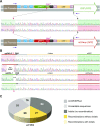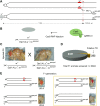CRISPR-induced double-strand breaks trigger recombination between homologous chromosome arms
- PMID: 31196871
- PMCID: PMC6587125
- DOI: 10.26508/lsa.201800267
CRISPR-induced double-strand breaks trigger recombination between homologous chromosome arms
Abstract
CRISPR-Cas9-based genome editing has transformed the life sciences, enabling virtually unlimited genetic manipulation of genomes: The RNA-guided Cas9 endonuclease cuts DNA at a specific target sequence and the resulting double-strand breaks are mended by one of the intrinsic cellular repair pathways. Imprecise double-strand repair will introduce random mutations such as indels or point mutations, whereas precise editing will restore or specifically edit the locus as mandated by an endogenous or exogenously provided template. Recent studies indicate that CRISPR-induced DNA cuts may also result in the exchange of genetic information between homologous chromosome arms. However, conclusive data of such recombination events in higher eukaryotes are lacking. Here, we show that in Drosophila, the detected Cas9-mediated editing events frequently resulted in germline-transmitted exchange of chromosome arms-often without indels. These findings demonstrate the feasibility of using the system for generating recombinants and also highlight an unforeseen risk of using CRISPR-Cas9 for therapeutic intervention.
© 2019 Brunner et al.
Conflict of interest statement
The authors declare that they have no conflict of interest.
Figures







References
Publication types
MeSH terms
Substances
LinkOut - more resources
Full Text Sources
Other Literature Sources
Molecular Biology Databases
Research Materials
